Analyzing Poverty in Nigeria: A Wicked Problem and Leadership
VerifiedAdded on 2020/09/09
|14
|3632
|106
Essay
AI Summary
This essay examines poverty in Nigeria as a 'wicked problem,' analyzing its complex nature and the challenges it presents. It applies the Competing Values Framework (CVF) to understand the interplay of competing values within the context of poverty, considering internal-external focus and flexibility...
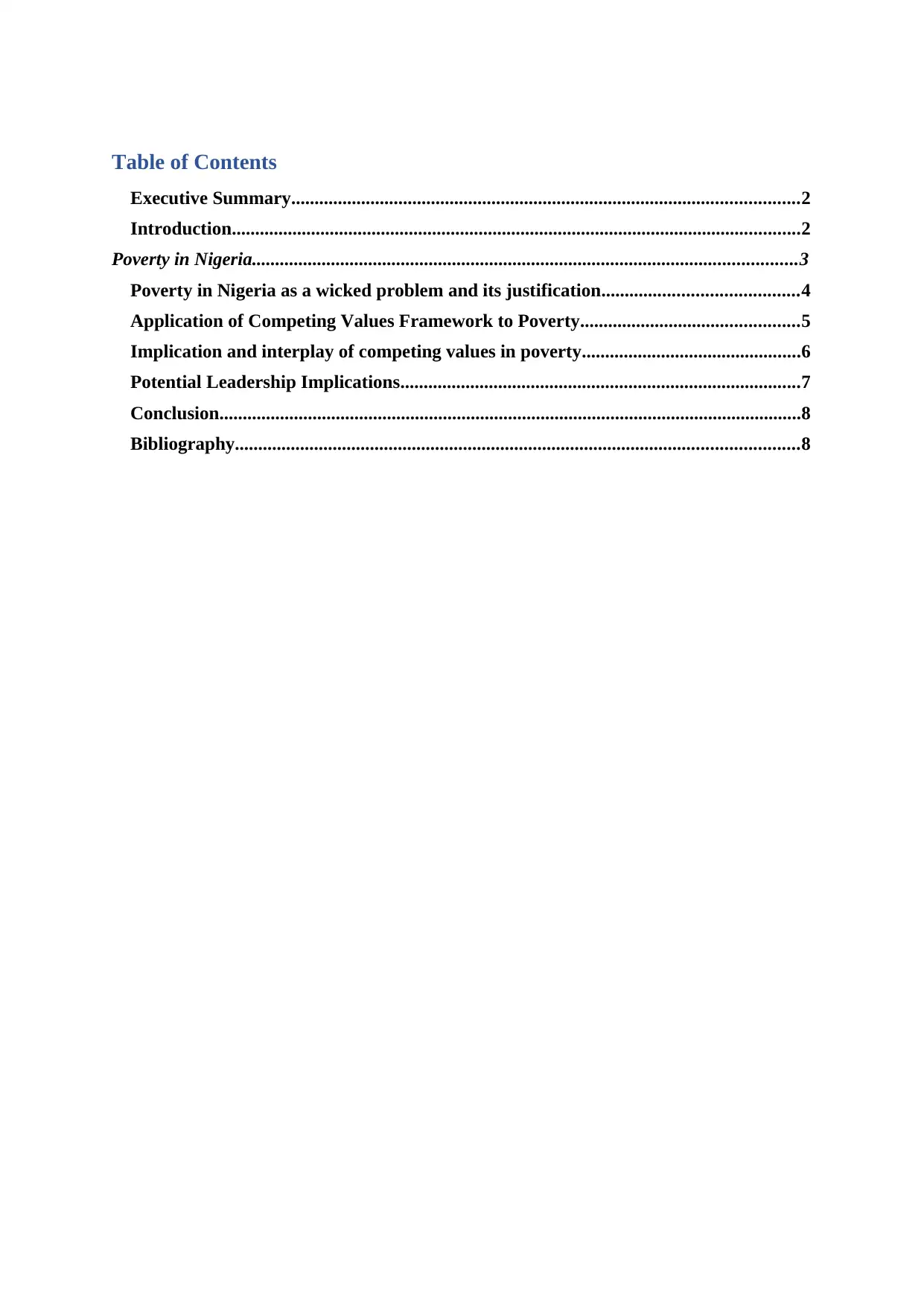
Table of Contents
Executive Summary.............................................................................................................2
Introduction..........................................................................................................................2
Poverty in Nigeria.....................................................................................................................3
Poverty in Nigeria as a wicked problem and its justification..........................................4
Application of Competing Values Framework to Poverty...............................................5
Implication and interplay of competing values in poverty...............................................6
Potential Leadership Implications......................................................................................7
Conclusion.............................................................................................................................8
Bibliography.........................................................................................................................8
Executive Summary.............................................................................................................2
Introduction..........................................................................................................................2
Poverty in Nigeria.....................................................................................................................3
Poverty in Nigeria as a wicked problem and its justification..........................................4
Application of Competing Values Framework to Poverty...............................................5
Implication and interplay of competing values in poverty...............................................6
Potential Leadership Implications......................................................................................7
Conclusion.............................................................................................................................8
Bibliography.........................................................................................................................8
Paraphrase This Document
Need a fresh take? Get an instant paraphrase of this document with our AI Paraphraser

Executive Summary
The objective of this essay is to identify a social issue and blend it with wick problem. The
essay emphasizes on poverty in the context of Nigeria and justifies it as a wicked problem.
Subsequently competing values framework is applied to the wicked problem of poverty and
further discusses the implications of competing values. The essay also elaborates on the
application of leadership (praxis) theory to determine the potential leadership implications to
mitigate poverty.
Introduction
Ever since the coining of word ‘wicked problem’ by the theorist Rittel and Webber in 1973,
the concept of wicked problem has increasingly gained popularity and use in the field of
public planning and policy (Thompson & Whyte, 2011). A wicked problem can be defined
as a social or cultural problem which are complicated in nature and apparently difficult or
almost impossible to solve by virtue of: incomplete or contradictory knowledge in
understanding the problem, involvement of numerous stakeholders with different opinions
and values, huge economic burden and interdependence of the problem with other problems
(Head,2008). Most of the wicked problems occur in social context and in turn it is the social
complexity of wicked problem that make them extremely tedious to manage (Navarro,
Hayward & Voros, 2008). Due to its complexity and wickedness, use of traditional methods
for problem solving to tackle wicked problem is futile and it indeed has become obsolete.
To vividly understand the nature of wicked problem, Rittel and Webber (1973) cited the
following characteristics:
1. The problem has no definitive formulation.
2. The problem has no stopping rule.
3. The solution can neither be completely correct nor completely wrong. It can only be
either good or bad.
4. There is no test to check whether the solution is right or wrong.
5. Every solution is a one shot operation. It can only be approached once
and cannot be undone.
6. There is no clear, single distinctive solution to the problem.
7. The problem is unique from other problems.
The objective of this essay is to identify a social issue and blend it with wick problem. The
essay emphasizes on poverty in the context of Nigeria and justifies it as a wicked problem.
Subsequently competing values framework is applied to the wicked problem of poverty and
further discusses the implications of competing values. The essay also elaborates on the
application of leadership (praxis) theory to determine the potential leadership implications to
mitigate poverty.
Introduction
Ever since the coining of word ‘wicked problem’ by the theorist Rittel and Webber in 1973,
the concept of wicked problem has increasingly gained popularity and use in the field of
public planning and policy (Thompson & Whyte, 2011). A wicked problem can be defined
as a social or cultural problem which are complicated in nature and apparently difficult or
almost impossible to solve by virtue of: incomplete or contradictory knowledge in
understanding the problem, involvement of numerous stakeholders with different opinions
and values, huge economic burden and interdependence of the problem with other problems
(Head,2008). Most of the wicked problems occur in social context and in turn it is the social
complexity of wicked problem that make them extremely tedious to manage (Navarro,
Hayward & Voros, 2008). Due to its complexity and wickedness, use of traditional methods
for problem solving to tackle wicked problem is futile and it indeed has become obsolete.
To vividly understand the nature of wicked problem, Rittel and Webber (1973) cited the
following characteristics:
1. The problem has no definitive formulation.
2. The problem has no stopping rule.
3. The solution can neither be completely correct nor completely wrong. It can only be
either good or bad.
4. There is no test to check whether the solution is right or wrong.
5. Every solution is a one shot operation. It can only be approached once
and cannot be undone.
6. There is no clear, single distinctive solution to the problem.
7. The problem is unique from other problems.
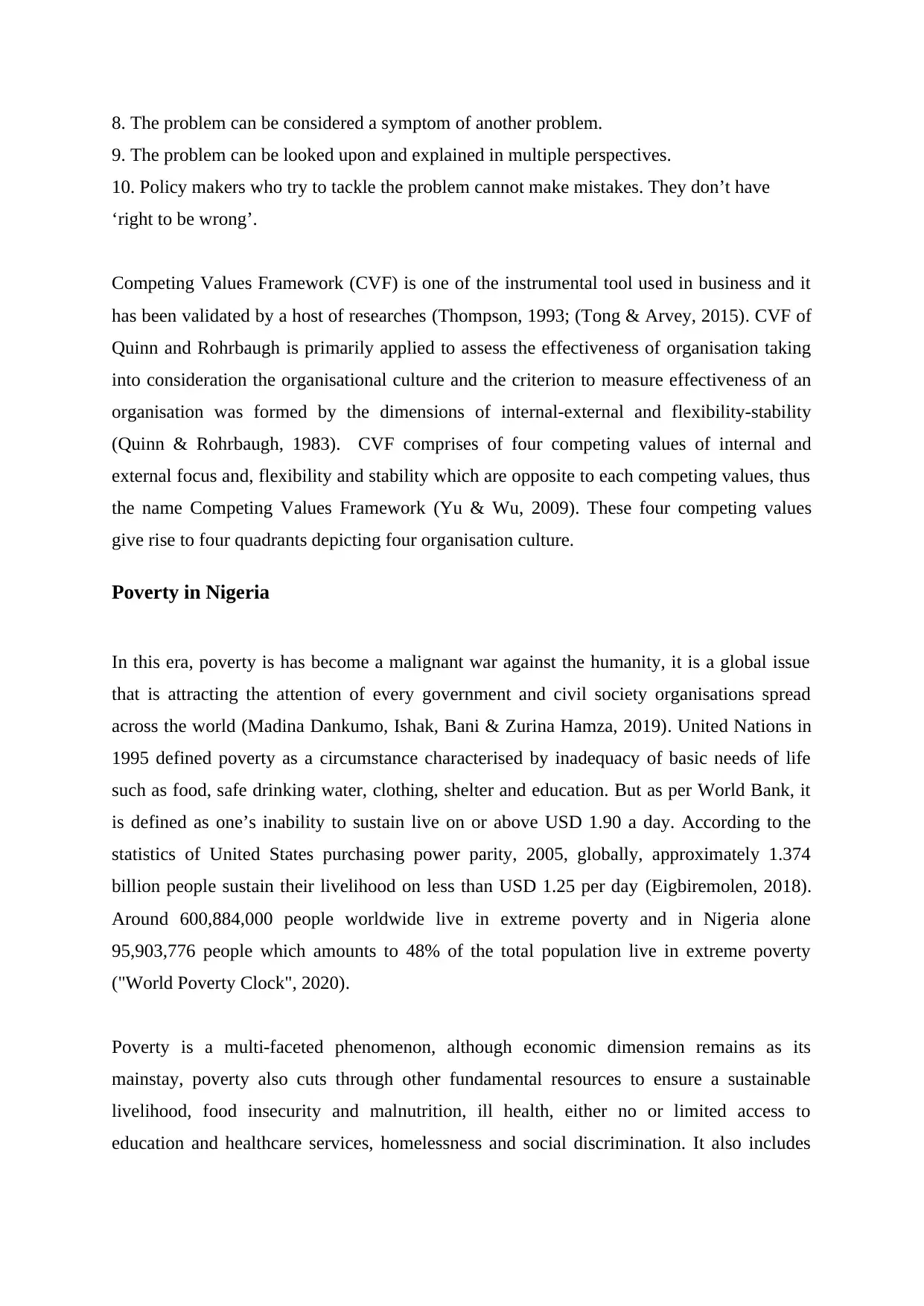
8. The problem can be considered a symptom of another problem.
9. The problem can be looked upon and explained in multiple perspectives.
10. Policy makers who try to tackle the problem cannot make mistakes. They don’t have
‘right to be wrong’.
Competing Values Framework (CVF) is one of the instrumental tool used in business and it
has been validated by a host of researches (Thompson, 1993; (Tong & Arvey, 2015). CVF of
Quinn and Rohrbaugh is primarily applied to assess the effectiveness of organisation taking
into consideration the organisational culture and the criterion to measure effectiveness of an
organisation was formed by the dimensions of internal-external and flexibility-stability
(Quinn & Rohrbaugh, 1983). CVF comprises of four competing values of internal and
external focus and, flexibility and stability which are opposite to each competing values, thus
the name Competing Values Framework (Yu & Wu, 2009). These four competing values
give rise to four quadrants depicting four organisation culture.
Poverty in Nigeria
In this era, poverty is has become a malignant war against the humanity, it is a global issue
that is attracting the attention of every government and civil society organisations spread
across the world (Madina Dankumo, Ishak, Bani & Zurina Hamza, 2019). United Nations in
1995 defined poverty as a circumstance characterised by inadequacy of basic needs of life
such as food, safe drinking water, clothing, shelter and education. But as per World Bank, it
is defined as one’s inability to sustain live on or above USD 1.90 a day. According to the
statistics of United States purchasing power parity, 2005, globally, approximately 1.374
billion people sustain their livelihood on less than USD 1.25 per day (Eigbiremolen, 2018).
Around 600,884,000 people worldwide live in extreme poverty and in Nigeria alone
95,903,776 people which amounts to 48% of the total population live in extreme poverty
("World Poverty Clock", 2020).
Poverty is a multi-faceted phenomenon, although economic dimension remains as its
mainstay, poverty also cuts through other fundamental resources to ensure a sustainable
livelihood, food insecurity and malnutrition, ill health, either no or limited access to
education and healthcare services, homelessness and social discrimination. It also includes
9. The problem can be looked upon and explained in multiple perspectives.
10. Policy makers who try to tackle the problem cannot make mistakes. They don’t have
‘right to be wrong’.
Competing Values Framework (CVF) is one of the instrumental tool used in business and it
has been validated by a host of researches (Thompson, 1993; (Tong & Arvey, 2015). CVF of
Quinn and Rohrbaugh is primarily applied to assess the effectiveness of organisation taking
into consideration the organisational culture and the criterion to measure effectiveness of an
organisation was formed by the dimensions of internal-external and flexibility-stability
(Quinn & Rohrbaugh, 1983). CVF comprises of four competing values of internal and
external focus and, flexibility and stability which are opposite to each competing values, thus
the name Competing Values Framework (Yu & Wu, 2009). These four competing values
give rise to four quadrants depicting four organisation culture.
Poverty in Nigeria
In this era, poverty is has become a malignant war against the humanity, it is a global issue
that is attracting the attention of every government and civil society organisations spread
across the world (Madina Dankumo, Ishak, Bani & Zurina Hamza, 2019). United Nations in
1995 defined poverty as a circumstance characterised by inadequacy of basic needs of life
such as food, safe drinking water, clothing, shelter and education. But as per World Bank, it
is defined as one’s inability to sustain live on or above USD 1.90 a day. According to the
statistics of United States purchasing power parity, 2005, globally, approximately 1.374
billion people sustain their livelihood on less than USD 1.25 per day (Eigbiremolen, 2018).
Around 600,884,000 people worldwide live in extreme poverty and in Nigeria alone
95,903,776 people which amounts to 48% of the total population live in extreme poverty
("World Poverty Clock", 2020).
Poverty is a multi-faceted phenomenon, although economic dimension remains as its
mainstay, poverty also cuts through other fundamental resources to ensure a sustainable
livelihood, food insecurity and malnutrition, ill health, either no or limited access to
education and healthcare services, homelessness and social discrimination. It also includes
⊘ This is a preview!⊘
Do you want full access?
Subscribe today to unlock all pages.

Trusted by 1+ million students worldwide
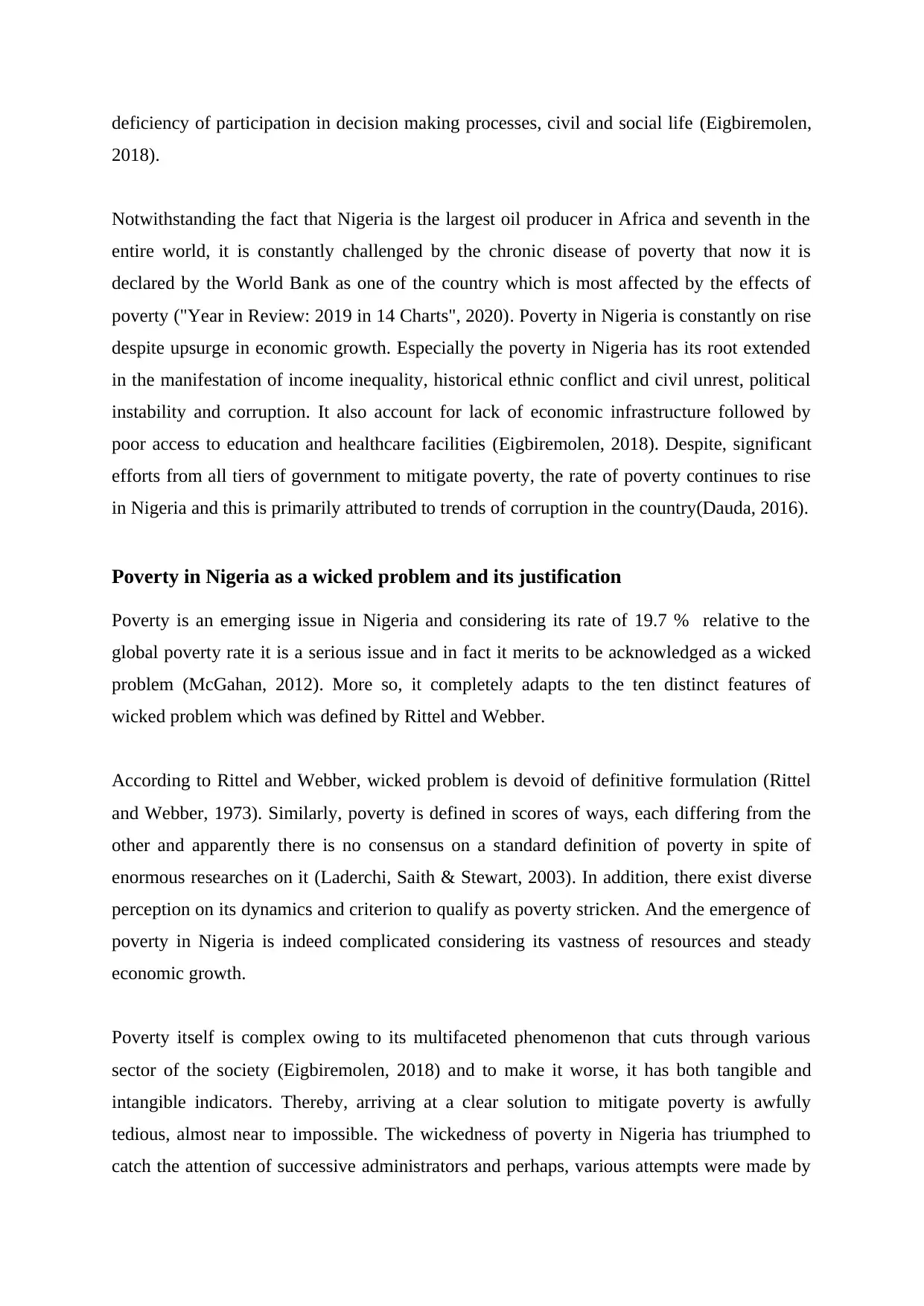
deficiency of participation in decision making processes, civil and social life (Eigbiremolen,
2018).
Notwithstanding the fact that Nigeria is the largest oil producer in Africa and seventh in the
entire world, it is constantly challenged by the chronic disease of poverty that now it is
declared by the World Bank as one of the country which is most affected by the effects of
poverty ("Year in Review: 2019 in 14 Charts", 2020). Poverty in Nigeria is constantly on rise
despite upsurge in economic growth. Especially the poverty in Nigeria has its root extended
in the manifestation of income inequality, historical ethnic conflict and civil unrest, political
instability and corruption. It also account for lack of economic infrastructure followed by
poor access to education and healthcare facilities (Eigbiremolen, 2018). Despite, significant
efforts from all tiers of government to mitigate poverty, the rate of poverty continues to rise
in Nigeria and this is primarily attributed to trends of corruption in the country(Dauda, 2016).
Poverty in Nigeria as a wicked problem and its justification
Poverty is an emerging issue in Nigeria and considering its rate of 19.7 % relative to the
global poverty rate it is a serious issue and in fact it merits to be acknowledged as a wicked
problem (McGahan, 2012). More so, it completely adapts to the ten distinct features of
wicked problem which was defined by Rittel and Webber.
According to Rittel and Webber, wicked problem is devoid of definitive formulation (Rittel
and Webber, 1973). Similarly, poverty is defined in scores of ways, each differing from the
other and apparently there is no consensus on a standard definition of poverty in spite of
enormous researches on it (Laderchi, Saith & Stewart, 2003). In addition, there exist diverse
perception on its dynamics and criterion to qualify as poverty stricken. And the emergence of
poverty in Nigeria is indeed complicated considering its vastness of resources and steady
economic growth.
Poverty itself is complex owing to its multifaceted phenomenon that cuts through various
sector of the society (Eigbiremolen, 2018) and to make it worse, it has both tangible and
intangible indicators. Thereby, arriving at a clear solution to mitigate poverty is awfully
tedious, almost near to impossible. The wickedness of poverty in Nigeria has triumphed to
catch the attention of successive administrators and perhaps, various attempts were made by
2018).
Notwithstanding the fact that Nigeria is the largest oil producer in Africa and seventh in the
entire world, it is constantly challenged by the chronic disease of poverty that now it is
declared by the World Bank as one of the country which is most affected by the effects of
poverty ("Year in Review: 2019 in 14 Charts", 2020). Poverty in Nigeria is constantly on rise
despite upsurge in economic growth. Especially the poverty in Nigeria has its root extended
in the manifestation of income inequality, historical ethnic conflict and civil unrest, political
instability and corruption. It also account for lack of economic infrastructure followed by
poor access to education and healthcare facilities (Eigbiremolen, 2018). Despite, significant
efforts from all tiers of government to mitigate poverty, the rate of poverty continues to rise
in Nigeria and this is primarily attributed to trends of corruption in the country(Dauda, 2016).
Poverty in Nigeria as a wicked problem and its justification
Poverty is an emerging issue in Nigeria and considering its rate of 19.7 % relative to the
global poverty rate it is a serious issue and in fact it merits to be acknowledged as a wicked
problem (McGahan, 2012). More so, it completely adapts to the ten distinct features of
wicked problem which was defined by Rittel and Webber.
According to Rittel and Webber, wicked problem is devoid of definitive formulation (Rittel
and Webber, 1973). Similarly, poverty is defined in scores of ways, each differing from the
other and apparently there is no consensus on a standard definition of poverty in spite of
enormous researches on it (Laderchi, Saith & Stewart, 2003). In addition, there exist diverse
perception on its dynamics and criterion to qualify as poverty stricken. And the emergence of
poverty in Nigeria is indeed complicated considering its vastness of resources and steady
economic growth.
Poverty itself is complex owing to its multifaceted phenomenon that cuts through various
sector of the society (Eigbiremolen, 2018) and to make it worse, it has both tangible and
intangible indicators. Thereby, arriving at a clear solution to mitigate poverty is awfully
tedious, almost near to impossible. The wickedness of poverty in Nigeria has triumphed to
catch the attention of successive administrators and perhaps, various attempts were made by
Paraphrase This Document
Need a fresh take? Get an instant paraphrase of this document with our AI Paraphraser
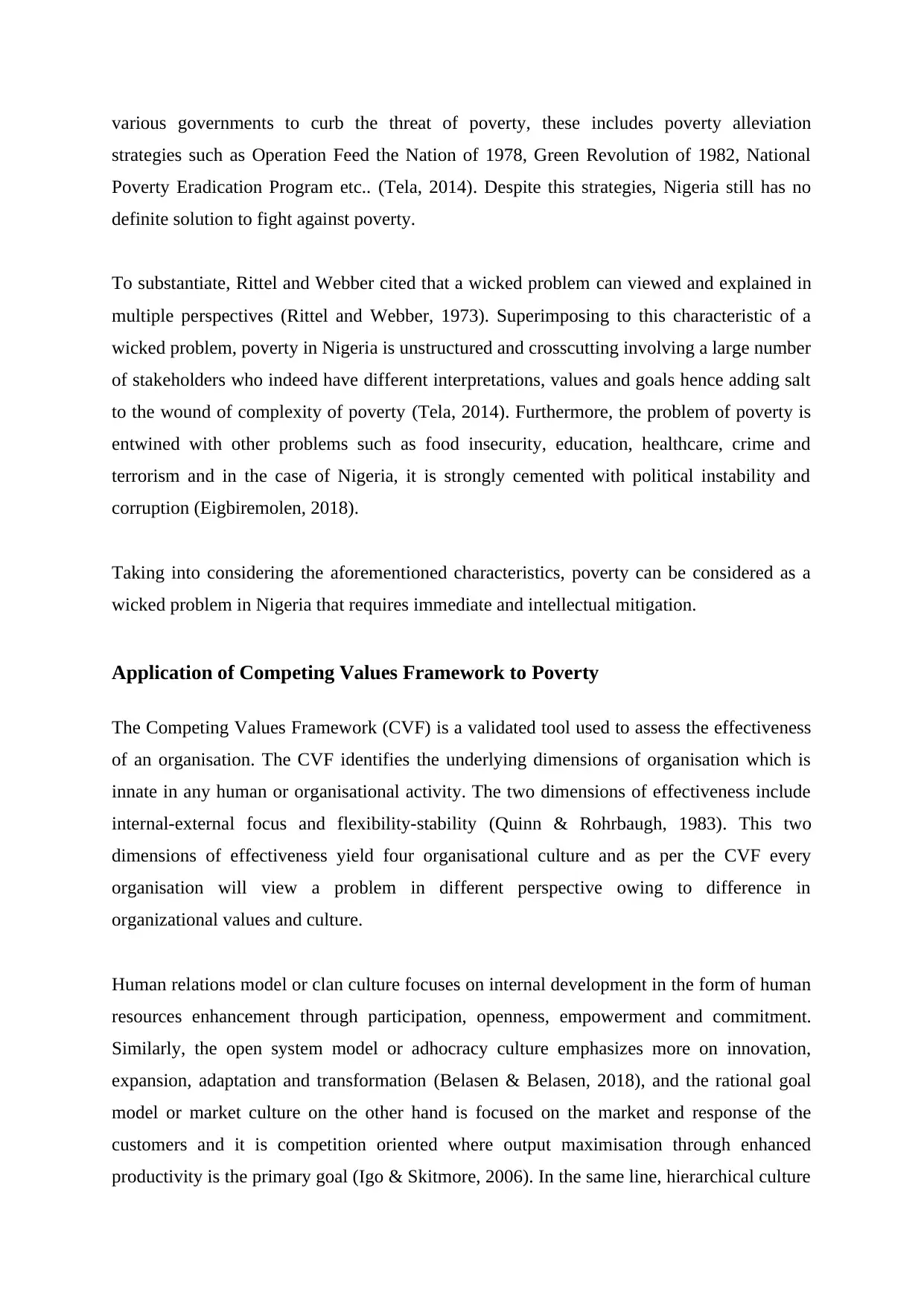
various governments to curb the threat of poverty, these includes poverty alleviation
strategies such as Operation Feed the Nation of 1978, Green Revolution of 1982, National
Poverty Eradication Program etc.. (Tela, 2014). Despite this strategies, Nigeria still has no
definite solution to fight against poverty.
To substantiate, Rittel and Webber cited that a wicked problem can viewed and explained in
multiple perspectives (Rittel and Webber, 1973). Superimposing to this characteristic of a
wicked problem, poverty in Nigeria is unstructured and crosscutting involving a large number
of stakeholders who indeed have different interpretations, values and goals hence adding salt
to the wound of complexity of poverty (Tela, 2014). Furthermore, the problem of poverty is
entwined with other problems such as food insecurity, education, healthcare, crime and
terrorism and in the case of Nigeria, it is strongly cemented with political instability and
corruption (Eigbiremolen, 2018).
Taking into considering the aforementioned characteristics, poverty can be considered as a
wicked problem in Nigeria that requires immediate and intellectual mitigation.
Application of Competing Values Framework to Poverty
The Competing Values Framework (CVF) is a validated tool used to assess the effectiveness
of an organisation. The CVF identifies the underlying dimensions of organisation which is
innate in any human or organisational activity. The two dimensions of effectiveness include
internal-external focus and flexibility-stability (Quinn & Rohrbaugh, 1983). This two
dimensions of effectiveness yield four organisational culture and as per the CVF every
organisation will view a problem in different perspective owing to difference in
organizational values and culture.
Human relations model or clan culture focuses on internal development in the form of human
resources enhancement through participation, openness, empowerment and commitment.
Similarly, the open system model or adhocracy culture emphasizes more on innovation,
expansion, adaptation and transformation (Belasen & Belasen, 2018), and the rational goal
model or market culture on the other hand is focused on the market and response of the
customers and it is competition oriented where output maximisation through enhanced
productivity is the primary goal (Igo & Skitmore, 2006). In the same line, hierarchical culture
strategies such as Operation Feed the Nation of 1978, Green Revolution of 1982, National
Poverty Eradication Program etc.. (Tela, 2014). Despite this strategies, Nigeria still has no
definite solution to fight against poverty.
To substantiate, Rittel and Webber cited that a wicked problem can viewed and explained in
multiple perspectives (Rittel and Webber, 1973). Superimposing to this characteristic of a
wicked problem, poverty in Nigeria is unstructured and crosscutting involving a large number
of stakeholders who indeed have different interpretations, values and goals hence adding salt
to the wound of complexity of poverty (Tela, 2014). Furthermore, the problem of poverty is
entwined with other problems such as food insecurity, education, healthcare, crime and
terrorism and in the case of Nigeria, it is strongly cemented with political instability and
corruption (Eigbiremolen, 2018).
Taking into considering the aforementioned characteristics, poverty can be considered as a
wicked problem in Nigeria that requires immediate and intellectual mitigation.
Application of Competing Values Framework to Poverty
The Competing Values Framework (CVF) is a validated tool used to assess the effectiveness
of an organisation. The CVF identifies the underlying dimensions of organisation which is
innate in any human or organisational activity. The two dimensions of effectiveness include
internal-external focus and flexibility-stability (Quinn & Rohrbaugh, 1983). This two
dimensions of effectiveness yield four organisational culture and as per the CVF every
organisation will view a problem in different perspective owing to difference in
organizational values and culture.
Human relations model or clan culture focuses on internal development in the form of human
resources enhancement through participation, openness, empowerment and commitment.
Similarly, the open system model or adhocracy culture emphasizes more on innovation,
expansion, adaptation and transformation (Belasen & Belasen, 2018), and the rational goal
model or market culture on the other hand is focused on the market and response of the
customers and it is competition oriented where output maximisation through enhanced
productivity is the primary goal (Igo & Skitmore, 2006). In the same line, hierarchical culture
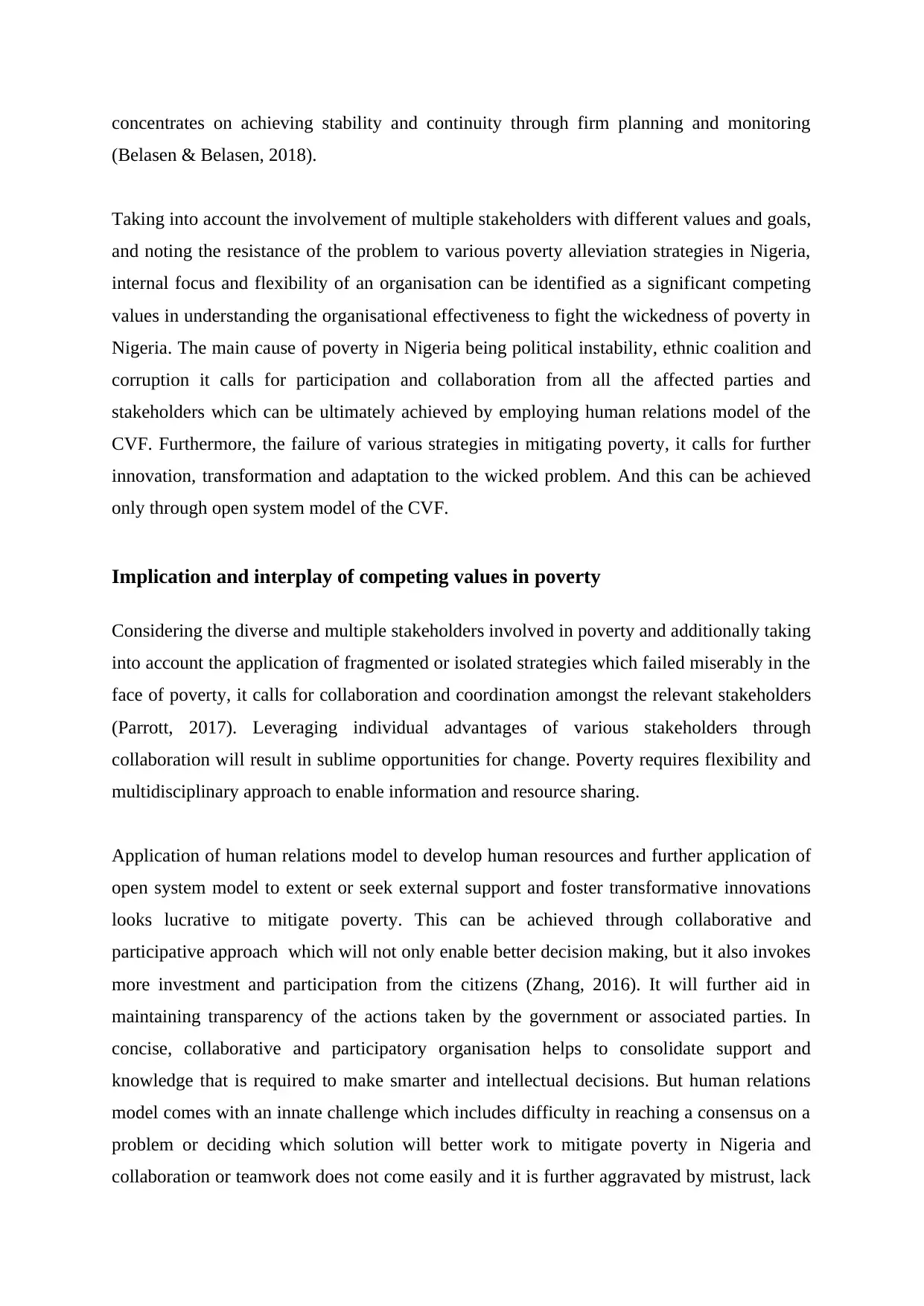
concentrates on achieving stability and continuity through firm planning and monitoring
(Belasen & Belasen, 2018).
Taking into account the involvement of multiple stakeholders with different values and goals,
and noting the resistance of the problem to various poverty alleviation strategies in Nigeria,
internal focus and flexibility of an organisation can be identified as a significant competing
values in understanding the organisational effectiveness to fight the wickedness of poverty in
Nigeria. The main cause of poverty in Nigeria being political instability, ethnic coalition and
corruption it calls for participation and collaboration from all the affected parties and
stakeholders which can be ultimately achieved by employing human relations model of the
CVF. Furthermore, the failure of various strategies in mitigating poverty, it calls for further
innovation, transformation and adaptation to the wicked problem. And this can be achieved
only through open system model of the CVF.
Implication and interplay of competing values in poverty
Considering the diverse and multiple stakeholders involved in poverty and additionally taking
into account the application of fragmented or isolated strategies which failed miserably in the
face of poverty, it calls for collaboration and coordination amongst the relevant stakeholders
(Parrott, 2017). Leveraging individual advantages of various stakeholders through
collaboration will result in sublime opportunities for change. Poverty requires flexibility and
multidisciplinary approach to enable information and resource sharing.
Application of human relations model to develop human resources and further application of
open system model to extent or seek external support and foster transformative innovations
looks lucrative to mitigate poverty. This can be achieved through collaborative and
participative approach which will not only enable better decision making, but it also invokes
more investment and participation from the citizens (Zhang, 2016). It will further aid in
maintaining transparency of the actions taken by the government or associated parties. In
concise, collaborative and participatory organisation helps to consolidate support and
knowledge that is required to make smarter and intellectual decisions. But human relations
model comes with an innate challenge which includes difficulty in reaching a consensus on a
problem or deciding which solution will better work to mitigate poverty in Nigeria and
collaboration or teamwork does not come easily and it is further aggravated by mistrust, lack
(Belasen & Belasen, 2018).
Taking into account the involvement of multiple stakeholders with different values and goals,
and noting the resistance of the problem to various poverty alleviation strategies in Nigeria,
internal focus and flexibility of an organisation can be identified as a significant competing
values in understanding the organisational effectiveness to fight the wickedness of poverty in
Nigeria. The main cause of poverty in Nigeria being political instability, ethnic coalition and
corruption it calls for participation and collaboration from all the affected parties and
stakeholders which can be ultimately achieved by employing human relations model of the
CVF. Furthermore, the failure of various strategies in mitigating poverty, it calls for further
innovation, transformation and adaptation to the wicked problem. And this can be achieved
only through open system model of the CVF.
Implication and interplay of competing values in poverty
Considering the diverse and multiple stakeholders involved in poverty and additionally taking
into account the application of fragmented or isolated strategies which failed miserably in the
face of poverty, it calls for collaboration and coordination amongst the relevant stakeholders
(Parrott, 2017). Leveraging individual advantages of various stakeholders through
collaboration will result in sublime opportunities for change. Poverty requires flexibility and
multidisciplinary approach to enable information and resource sharing.
Application of human relations model to develop human resources and further application of
open system model to extent or seek external support and foster transformative innovations
looks lucrative to mitigate poverty. This can be achieved through collaborative and
participative approach which will not only enable better decision making, but it also invokes
more investment and participation from the citizens (Zhang, 2016). It will further aid in
maintaining transparency of the actions taken by the government or associated parties. In
concise, collaborative and participatory organisation helps to consolidate support and
knowledge that is required to make smarter and intellectual decisions. But human relations
model comes with an innate challenge which includes difficulty in reaching a consensus on a
problem or deciding which solution will better work to mitigate poverty in Nigeria and
collaboration or teamwork does not come easily and it is further aggravated by mistrust, lack
⊘ This is a preview!⊘
Do you want full access?
Subscribe today to unlock all pages.

Trusted by 1+ million students worldwide
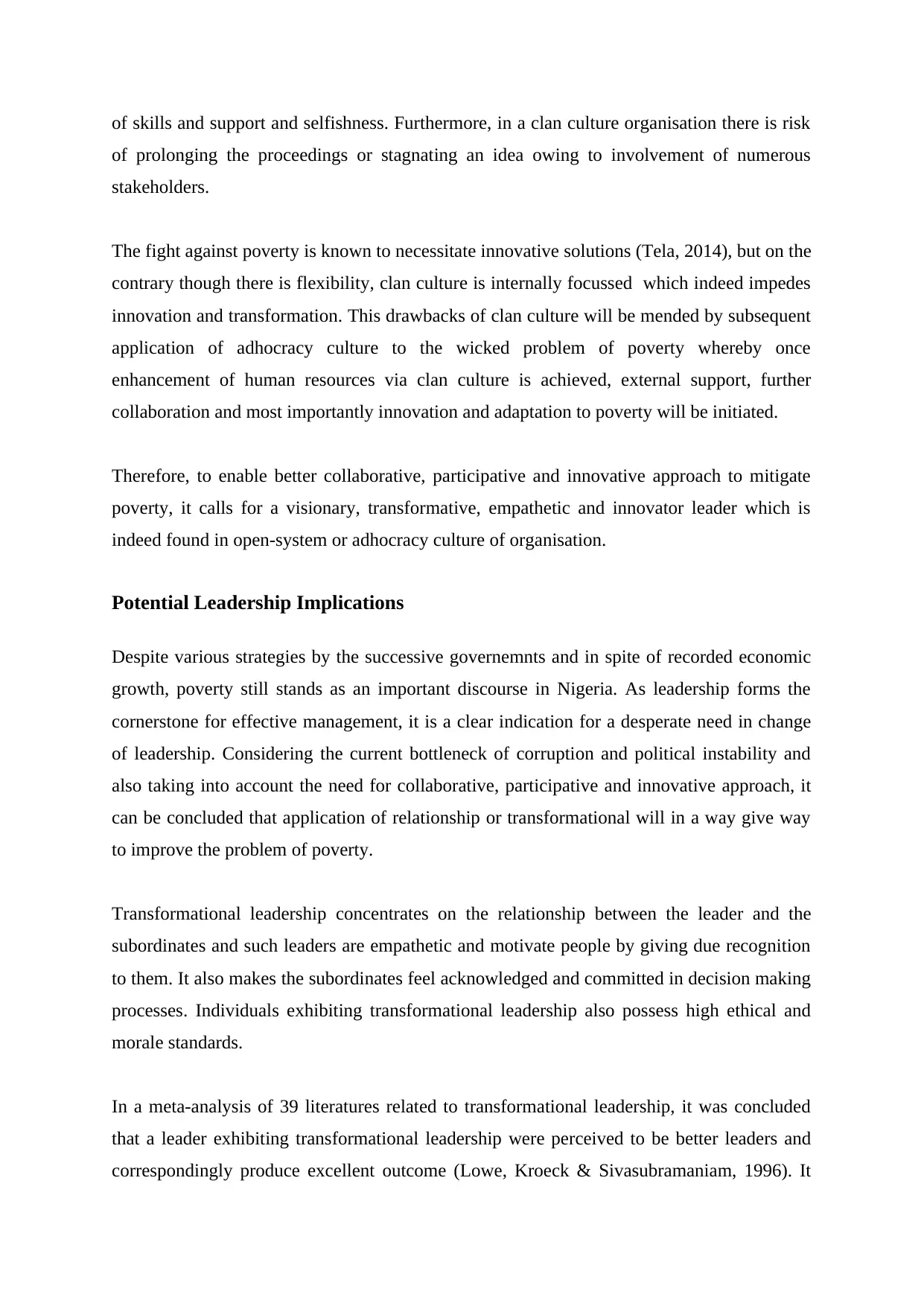
of skills and support and selfishness. Furthermore, in a clan culture organisation there is risk
of prolonging the proceedings or stagnating an idea owing to involvement of numerous
stakeholders.
The fight against poverty is known to necessitate innovative solutions (Tela, 2014), but on the
contrary though there is flexibility, clan culture is internally focussed which indeed impedes
innovation and transformation. This drawbacks of clan culture will be mended by subsequent
application of adhocracy culture to the wicked problem of poverty whereby once
enhancement of human resources via clan culture is achieved, external support, further
collaboration and most importantly innovation and adaptation to poverty will be initiated.
Therefore, to enable better collaborative, participative and innovative approach to mitigate
poverty, it calls for a visionary, transformative, empathetic and innovator leader which is
indeed found in open-system or adhocracy culture of organisation.
Potential Leadership Implications
Despite various strategies by the successive governemnts and in spite of recorded economic
growth, poverty still stands as an important discourse in Nigeria. As leadership forms the
cornerstone for effective management, it is a clear indication for a desperate need in change
of leadership. Considering the current bottleneck of corruption and political instability and
also taking into account the need for collaborative, participative and innovative approach, it
can be concluded that application of relationship or transformational will in a way give way
to improve the problem of poverty.
Transformational leadership concentrates on the relationship between the leader and the
subordinates and such leaders are empathetic and motivate people by giving due recognition
to them. It also makes the subordinates feel acknowledged and committed in decision making
processes. Individuals exhibiting transformational leadership also possess high ethical and
morale standards.
In a meta-analysis of 39 literatures related to transformational leadership, it was concluded
that a leader exhibiting transformational leadership were perceived to be better leaders and
correspondingly produce excellent outcome (Lowe, Kroeck & Sivasubramaniam, 1996). It
of prolonging the proceedings or stagnating an idea owing to involvement of numerous
stakeholders.
The fight against poverty is known to necessitate innovative solutions (Tela, 2014), but on the
contrary though there is flexibility, clan culture is internally focussed which indeed impedes
innovation and transformation. This drawbacks of clan culture will be mended by subsequent
application of adhocracy culture to the wicked problem of poverty whereby once
enhancement of human resources via clan culture is achieved, external support, further
collaboration and most importantly innovation and adaptation to poverty will be initiated.
Therefore, to enable better collaborative, participative and innovative approach to mitigate
poverty, it calls for a visionary, transformative, empathetic and innovator leader which is
indeed found in open-system or adhocracy culture of organisation.
Potential Leadership Implications
Despite various strategies by the successive governemnts and in spite of recorded economic
growth, poverty still stands as an important discourse in Nigeria. As leadership forms the
cornerstone for effective management, it is a clear indication for a desperate need in change
of leadership. Considering the current bottleneck of corruption and political instability and
also taking into account the need for collaborative, participative and innovative approach, it
can be concluded that application of relationship or transformational will in a way give way
to improve the problem of poverty.
Transformational leadership concentrates on the relationship between the leader and the
subordinates and such leaders are empathetic and motivate people by giving due recognition
to them. It also makes the subordinates feel acknowledged and committed in decision making
processes. Individuals exhibiting transformational leadership also possess high ethical and
morale standards.
In a meta-analysis of 39 literatures related to transformational leadership, it was concluded
that a leader exhibiting transformational leadership were perceived to be better leaders and
correspondingly produce excellent outcome (Lowe, Kroeck & Sivasubramaniam, 1996). It
Paraphrase This Document
Need a fresh take? Get an instant paraphrase of this document with our AI Paraphraser

was also found that a strong positive correlation exist between transformational leadership
and subordinate satisfaction with supervision. Furthermore, transformational leadership is
also known to result increased commitment from the subordinates (Testa, 2002). Therefore,
transformational leadership can be used in consolidating teamwork, in decision making
masses and to foster quality initiatives and reorganisation in the field of poverty.
Conclusion
No community is immune to poverty and its adverse effects. Poverty is an important
discourse in Nigeria and it has in fact attracted the attention of successive government. But
issues such as corruption, political instability and social discrimination has aggravated the
problem of poverty. Referring to the characteristics of wicked problem, poverty in Nigeria
tremendously merits to be considered as a severe wicked problem requiring thoughtful
attention. Finally, to infer, a transformational and participative leadership and change in
organization culture has the potential to change the face of poverty and provide a better
solution to improve poverty in Nigeria.
Poverty
alleviation strategies ranging
from Operation Feed the
Nation
of 1978, the Green
Revolution of 1982, the
Directorate of
Foods Roads and Rural
Infrastructures DFFRI, the
National
and subordinate satisfaction with supervision. Furthermore, transformational leadership is
also known to result increased commitment from the subordinates (Testa, 2002). Therefore,
transformational leadership can be used in consolidating teamwork, in decision making
masses and to foster quality initiatives and reorganisation in the field of poverty.
Conclusion
No community is immune to poverty and its adverse effects. Poverty is an important
discourse in Nigeria and it has in fact attracted the attention of successive government. But
issues such as corruption, political instability and social discrimination has aggravated the
problem of poverty. Referring to the characteristics of wicked problem, poverty in Nigeria
tremendously merits to be considered as a severe wicked problem requiring thoughtful
attention. Finally, to infer, a transformational and participative leadership and change in
organization culture has the potential to change the face of poverty and provide a better
solution to improve poverty in Nigeria.
Poverty
alleviation strategies ranging
from Operation Feed the
Nation
of 1978, the Green
Revolution of 1982, the
Directorate of
Foods Roads and Rural
Infrastructures DFFRI, the
National
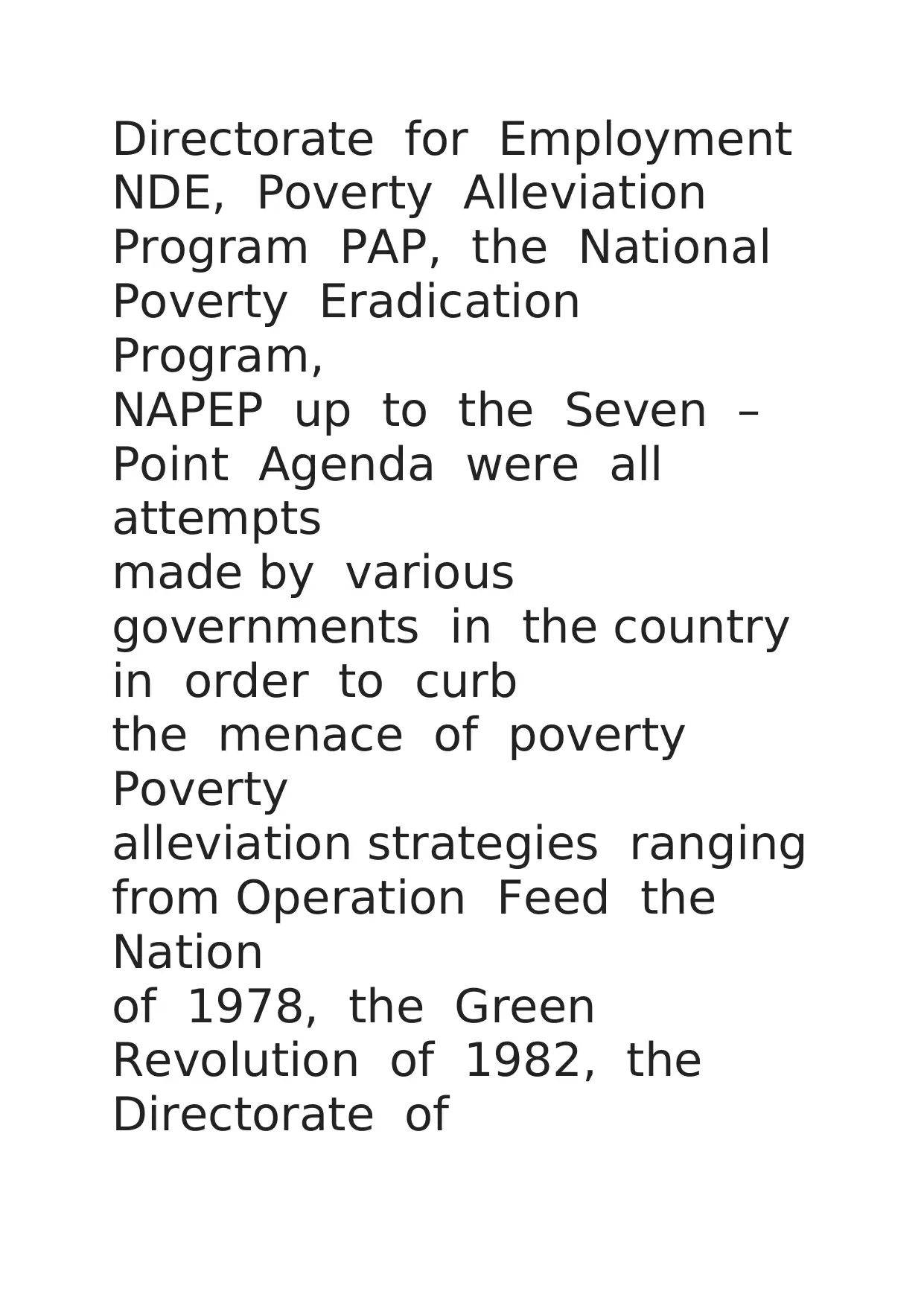
Directorate for Employment
NDE, Poverty Alleviation
Program PAP, the National
Poverty Eradication
Program,
NAPEP up to the Seven –
Point Agenda were all
attempts
made by various
governments in the country
in order to curb
the menace of poverty
Poverty
alleviation strategies ranging
from Operation Feed the
Nation
of 1978, the Green
Revolution of 1982, the
Directorate of
NDE, Poverty Alleviation
Program PAP, the National
Poverty Eradication
Program,
NAPEP up to the Seven –
Point Agenda were all
attempts
made by various
governments in the country
in order to curb
the menace of poverty
Poverty
alleviation strategies ranging
from Operation Feed the
Nation
of 1978, the Green
Revolution of 1982, the
Directorate of
⊘ This is a preview!⊘
Do you want full access?
Subscribe today to unlock all pages.

Trusted by 1+ million students worldwide
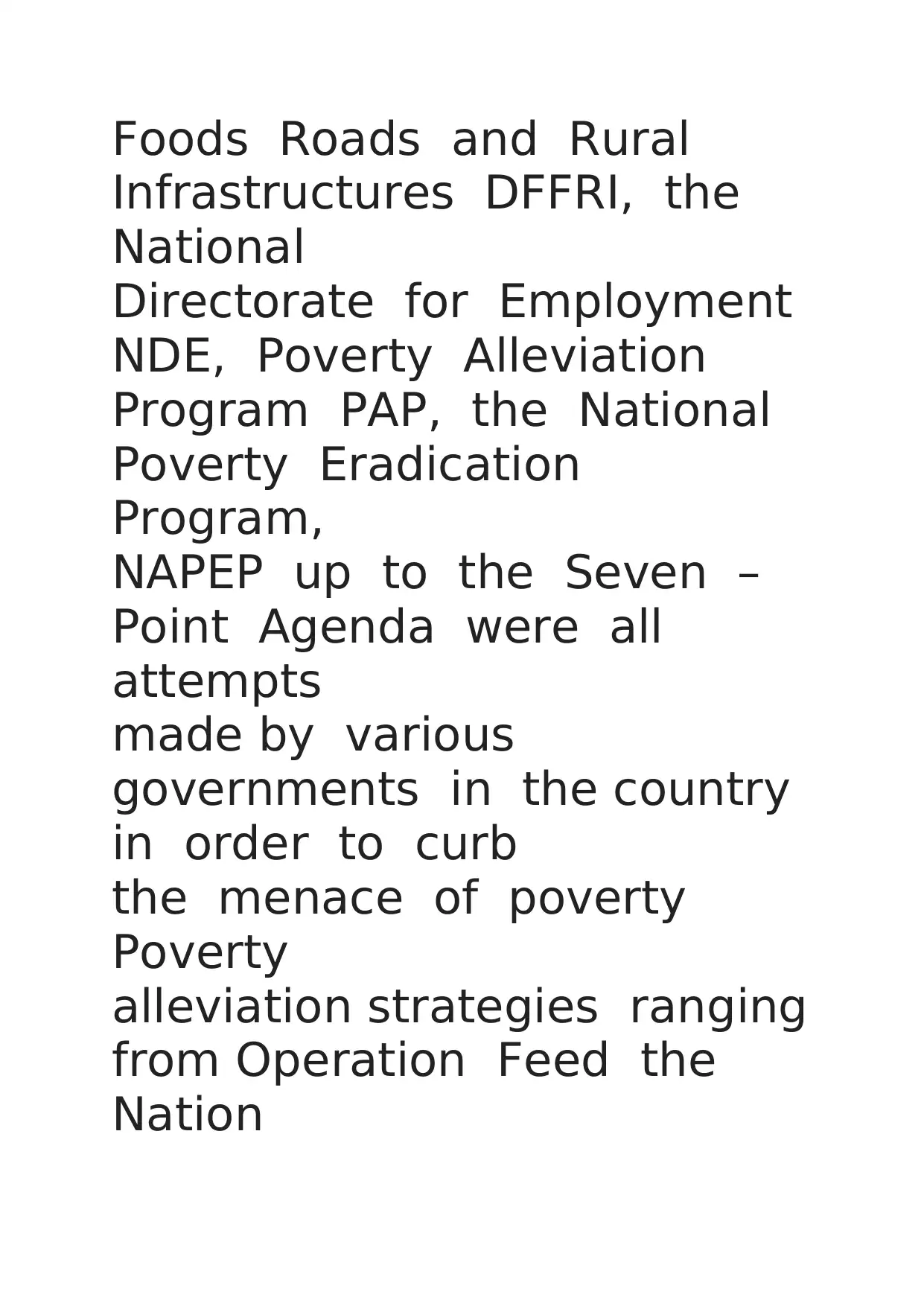
Foods Roads and Rural
Infrastructures DFFRI, the
National
Directorate for Employment
NDE, Poverty Alleviation
Program PAP, the National
Poverty Eradication
Program,
NAPEP up to the Seven –
Point Agenda were all
attempts
made by various
governments in the country
in order to curb
the menace of poverty
Poverty
alleviation strategies ranging
from Operation Feed the
Nation
Infrastructures DFFRI, the
National
Directorate for Employment
NDE, Poverty Alleviation
Program PAP, the National
Poverty Eradication
Program,
NAPEP up to the Seven –
Point Agenda were all
attempts
made by various
governments in the country
in order to curb
the menace of poverty
Poverty
alleviation strategies ranging
from Operation Feed the
Nation
Paraphrase This Document
Need a fresh take? Get an instant paraphrase of this document with our AI Paraphraser
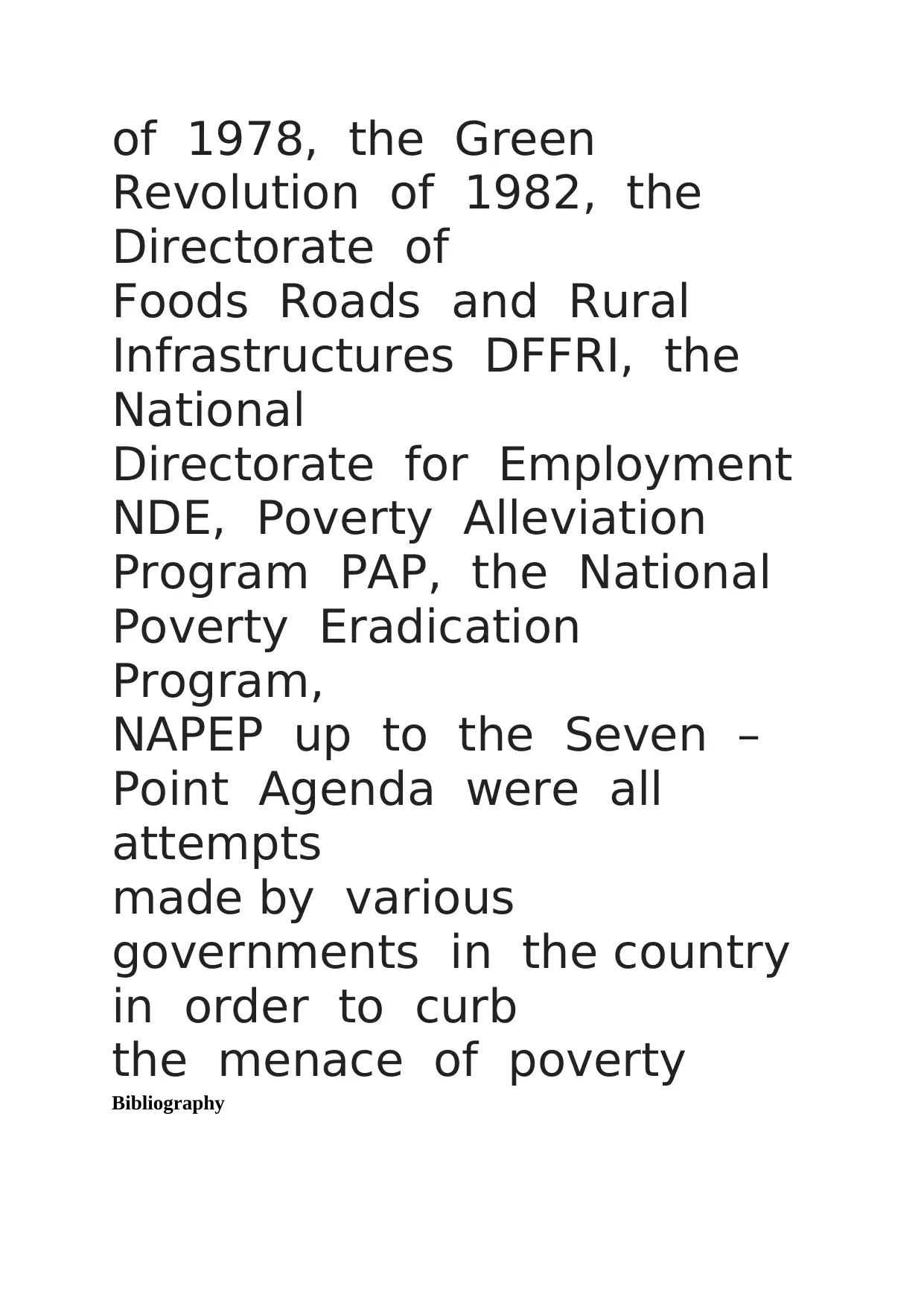
of 1978, the Green
Revolution of 1982, the
Directorate of
Foods Roads and Rural
Infrastructures DFFRI, the
National
Directorate for Employment
NDE, Poverty Alleviation
Program PAP, the National
Poverty Eradication
Program,
NAPEP up to the Seven –
Point Agenda were all
attempts
made by various
governments in the country
in order to curb
the menace of poverty
Bibliography
Revolution of 1982, the
Directorate of
Foods Roads and Rural
Infrastructures DFFRI, the
National
Directorate for Employment
NDE, Poverty Alleviation
Program PAP, the National
Poverty Eradication
Program,
NAPEP up to the Seven –
Point Agenda were all
attempts
made by various
governments in the country
in order to curb
the menace of poverty
Bibliography
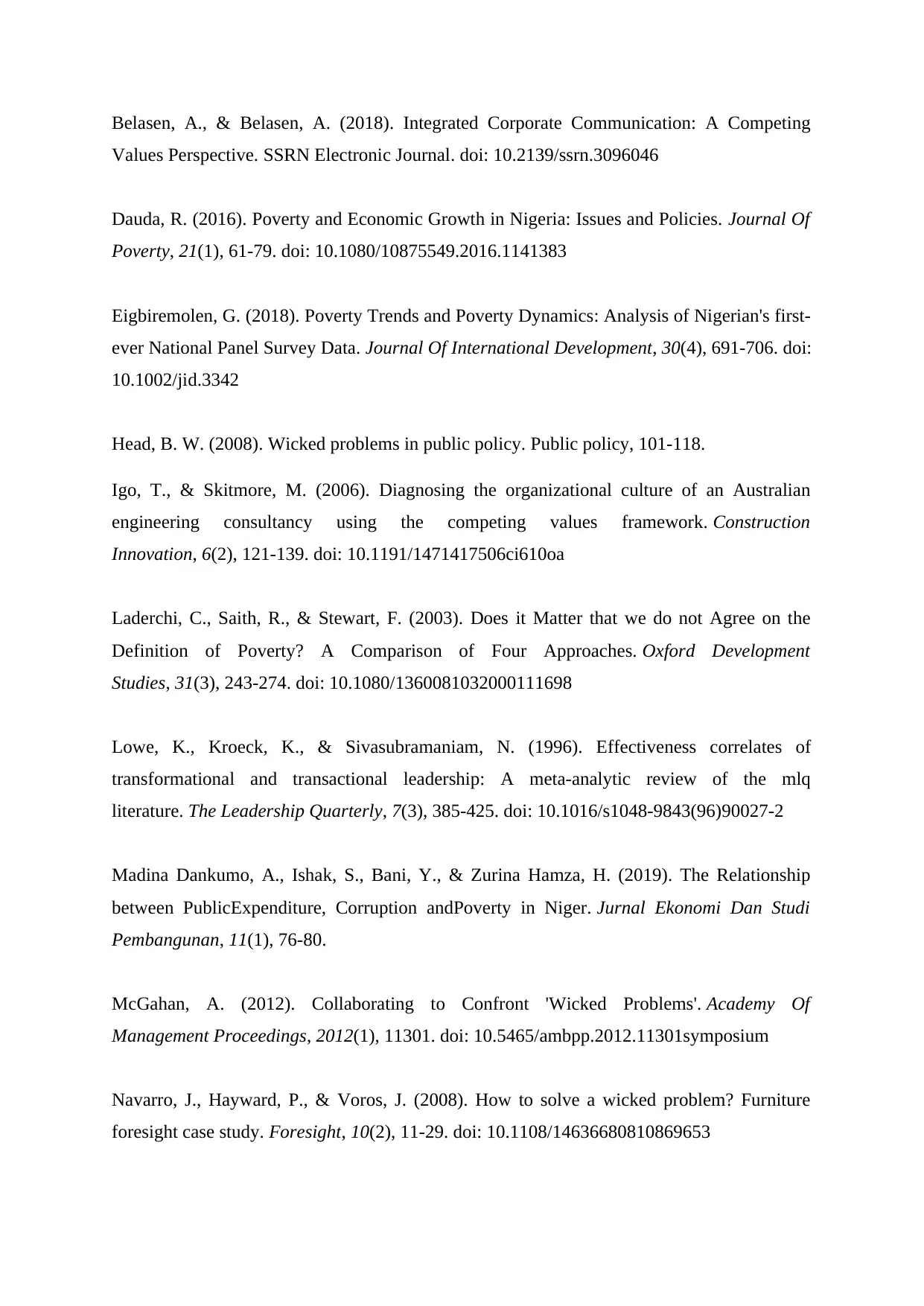
Belasen, A., & Belasen, A. (2018). Integrated Corporate Communication: A Competing
Values Perspective. SSRN Electronic Journal. doi: 10.2139/ssrn.3096046
Dauda, R. (2016). Poverty and Economic Growth in Nigeria: Issues and Policies. Journal Of
Poverty, 21(1), 61-79. doi: 10.1080/10875549.2016.1141383
Eigbiremolen, G. (2018). Poverty Trends and Poverty Dynamics: Analysis of Nigerian's first-
ever National Panel Survey Data. Journal Of International Development, 30(4), 691-706. doi:
10.1002/jid.3342
Head, B. W. (2008). Wicked problems in public policy. Public policy, 101-118.
Igo, T., & Skitmore, M. (2006). Diagnosing the organizational culture of an Australian
engineering consultancy using the competing values framework. Construction
Innovation, 6(2), 121-139. doi: 10.1191/1471417506ci610oa
Laderchi, C., Saith, R., & Stewart, F. (2003). Does it Matter that we do not Agree on the
Definition of Poverty? A Comparison of Four Approaches. Oxford Development
Studies, 31(3), 243-274. doi: 10.1080/1360081032000111698
Lowe, K., Kroeck, K., & Sivasubramaniam, N. (1996). Effectiveness correlates of
transformational and transactional leadership: A meta-analytic review of the mlq
literature. The Leadership Quarterly, 7(3), 385-425. doi: 10.1016/s1048-9843(96)90027-2
Madina Dankumo, A., Ishak, S., Bani, Y., & Zurina Hamza, H. (2019). The Relationship
between PublicExpenditure, Corruption andPoverty in Niger. Jurnal Ekonomi Dan Studi
Pembangunan, 11(1), 76-80.
McGahan, A. (2012). Collaborating to Confront 'Wicked Problems'. Academy Of
Management Proceedings, 2012(1), 11301. doi: 10.5465/ambpp.2012.11301symposium
Navarro, J., Hayward, P., & Voros, J. (2008). How to solve a wicked problem? Furniture
foresight case study. Foresight, 10(2), 11-29. doi: 10.1108/14636680810869653
Values Perspective. SSRN Electronic Journal. doi: 10.2139/ssrn.3096046
Dauda, R. (2016). Poverty and Economic Growth in Nigeria: Issues and Policies. Journal Of
Poverty, 21(1), 61-79. doi: 10.1080/10875549.2016.1141383
Eigbiremolen, G. (2018). Poverty Trends and Poverty Dynamics: Analysis of Nigerian's first-
ever National Panel Survey Data. Journal Of International Development, 30(4), 691-706. doi:
10.1002/jid.3342
Head, B. W. (2008). Wicked problems in public policy. Public policy, 101-118.
Igo, T., & Skitmore, M. (2006). Diagnosing the organizational culture of an Australian
engineering consultancy using the competing values framework. Construction
Innovation, 6(2), 121-139. doi: 10.1191/1471417506ci610oa
Laderchi, C., Saith, R., & Stewart, F. (2003). Does it Matter that we do not Agree on the
Definition of Poverty? A Comparison of Four Approaches. Oxford Development
Studies, 31(3), 243-274. doi: 10.1080/1360081032000111698
Lowe, K., Kroeck, K., & Sivasubramaniam, N. (1996). Effectiveness correlates of
transformational and transactional leadership: A meta-analytic review of the mlq
literature. The Leadership Quarterly, 7(3), 385-425. doi: 10.1016/s1048-9843(96)90027-2
Madina Dankumo, A., Ishak, S., Bani, Y., & Zurina Hamza, H. (2019). The Relationship
between PublicExpenditure, Corruption andPoverty in Niger. Jurnal Ekonomi Dan Studi
Pembangunan, 11(1), 76-80.
McGahan, A. (2012). Collaborating to Confront 'Wicked Problems'. Academy Of
Management Proceedings, 2012(1), 11301. doi: 10.5465/ambpp.2012.11301symposium
Navarro, J., Hayward, P., & Voros, J. (2008). How to solve a wicked problem? Furniture
foresight case study. Foresight, 10(2), 11-29. doi: 10.1108/14636680810869653
⊘ This is a preview!⊘
Do you want full access?
Subscribe today to unlock all pages.

Trusted by 1+ million students worldwide
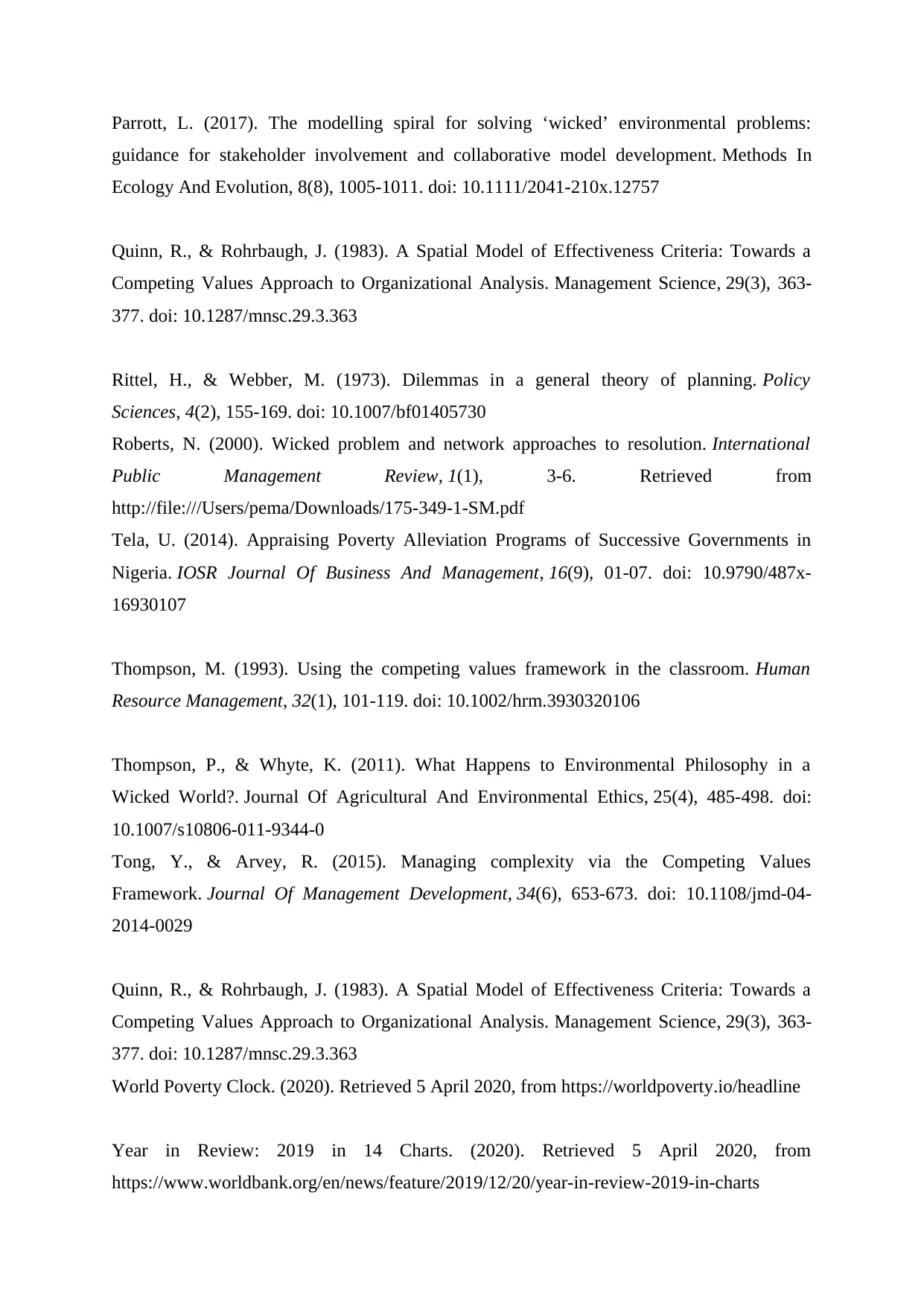
Parrott, L. (2017). The modelling spiral for solving ‘wicked’ environmental problems:
guidance for stakeholder involvement and collaborative model development. Methods In
Ecology And Evolution, 8(8), 1005-1011. doi: 10.1111/2041-210x.12757
Quinn, R., & Rohrbaugh, J. (1983). A Spatial Model of Effectiveness Criteria: Towards a
Competing Values Approach to Organizational Analysis. Management Science, 29(3), 363-
377. doi: 10.1287/mnsc.29.3.363
Rittel, H., & Webber, M. (1973). Dilemmas in a general theory of planning. Policy
Sciences, 4(2), 155-169. doi: 10.1007/bf01405730
Roberts, N. (2000). Wicked problem and network approaches to resolution. International
Public Management Review, 1(1), 3-6. Retrieved from
http://file:///Users/pema/Downloads/175-349-1-SM.pdf
Tela, U. (2014). Appraising Poverty Alleviation Programs of Successive Governments in
Nigeria. IOSR Journal Of Business And Management, 16(9), 01-07. doi: 10.9790/487x-
16930107
Thompson, M. (1993). Using the competing values framework in the classroom. Human
Resource Management, 32(1), 101-119. doi: 10.1002/hrm.3930320106
Thompson, P., & Whyte, K. (2011). What Happens to Environmental Philosophy in a
Wicked World?. Journal Of Agricultural And Environmental Ethics, 25(4), 485-498. doi:
10.1007/s10806-011-9344-0
Tong, Y., & Arvey, R. (2015). Managing complexity via the Competing Values
Framework. Journal Of Management Development, 34(6), 653-673. doi: 10.1108/jmd-04-
2014-0029
Quinn, R., & Rohrbaugh, J. (1983). A Spatial Model of Effectiveness Criteria: Towards a
Competing Values Approach to Organizational Analysis. Management Science, 29(3), 363-
377. doi: 10.1287/mnsc.29.3.363
World Poverty Clock. (2020). Retrieved 5 April 2020, from https://worldpoverty.io/headline
Year in Review: 2019 in 14 Charts. (2020). Retrieved 5 April 2020, from
https://www.worldbank.org/en/news/feature/2019/12/20/year-in-review-2019-in-charts
guidance for stakeholder involvement and collaborative model development. Methods In
Ecology And Evolution, 8(8), 1005-1011. doi: 10.1111/2041-210x.12757
Quinn, R., & Rohrbaugh, J. (1983). A Spatial Model of Effectiveness Criteria: Towards a
Competing Values Approach to Organizational Analysis. Management Science, 29(3), 363-
377. doi: 10.1287/mnsc.29.3.363
Rittel, H., & Webber, M. (1973). Dilemmas in a general theory of planning. Policy
Sciences, 4(2), 155-169. doi: 10.1007/bf01405730
Roberts, N. (2000). Wicked problem and network approaches to resolution. International
Public Management Review, 1(1), 3-6. Retrieved from
http://file:///Users/pema/Downloads/175-349-1-SM.pdf
Tela, U. (2014). Appraising Poverty Alleviation Programs of Successive Governments in
Nigeria. IOSR Journal Of Business And Management, 16(9), 01-07. doi: 10.9790/487x-
16930107
Thompson, M. (1993). Using the competing values framework in the classroom. Human
Resource Management, 32(1), 101-119. doi: 10.1002/hrm.3930320106
Thompson, P., & Whyte, K. (2011). What Happens to Environmental Philosophy in a
Wicked World?. Journal Of Agricultural And Environmental Ethics, 25(4), 485-498. doi:
10.1007/s10806-011-9344-0
Tong, Y., & Arvey, R. (2015). Managing complexity via the Competing Values
Framework. Journal Of Management Development, 34(6), 653-673. doi: 10.1108/jmd-04-
2014-0029
Quinn, R., & Rohrbaugh, J. (1983). A Spatial Model of Effectiveness Criteria: Towards a
Competing Values Approach to Organizational Analysis. Management Science, 29(3), 363-
377. doi: 10.1287/mnsc.29.3.363
World Poverty Clock. (2020). Retrieved 5 April 2020, from https://worldpoverty.io/headline
Year in Review: 2019 in 14 Charts. (2020). Retrieved 5 April 2020, from
https://www.worldbank.org/en/news/feature/2019/12/20/year-in-review-2019-in-charts
Paraphrase This Document
Need a fresh take? Get an instant paraphrase of this document with our AI Paraphraser
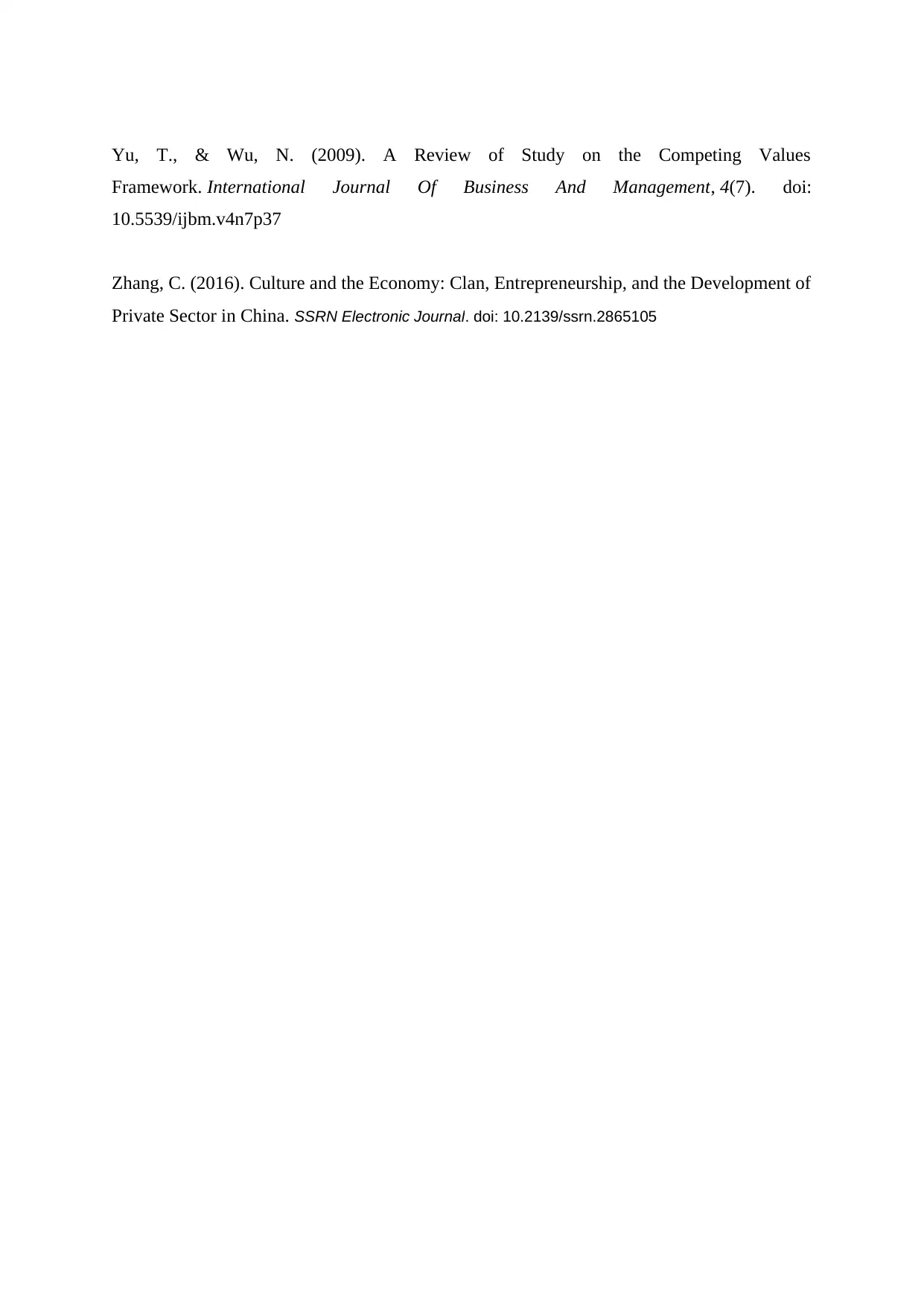
Yu, T., & Wu, N. (2009). A Review of Study on the Competing Values
Framework. International Journal Of Business And Management, 4(7). doi:
10.5539/ijbm.v4n7p37
Zhang, C. (2016). Culture and the Economy: Clan, Entrepreneurship, and the Development of
Private Sector in China. SSRN Electronic Journal. doi: 10.2139/ssrn.2865105
Framework. International Journal Of Business And Management, 4(7). doi:
10.5539/ijbm.v4n7p37
Zhang, C. (2016). Culture and the Economy: Clan, Entrepreneurship, and the Development of
Private Sector in China. SSRN Electronic Journal. doi: 10.2139/ssrn.2865105
1 out of 14
Related Documents
Your All-in-One AI-Powered Toolkit for Academic Success.
+13062052269
info@desklib.com
Available 24*7 on WhatsApp / Email
![[object Object]](/_next/static/media/star-bottom.7253800d.svg)
Unlock your academic potential
© 2024 | Zucol Services PVT LTD | All rights reserved.




